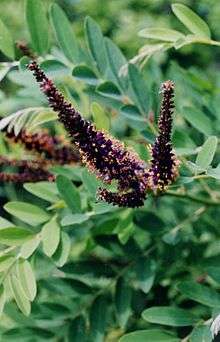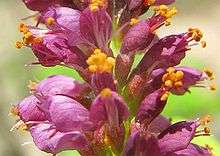Amorpha
Amorpha is a genus of plants in the pea family, Fabaceae. All the species are native to North America, from southern Canada, most of the United States (US), and northern Mexico. They are commonly known as false indigo. The name Amorpha means "deformed" or "without form" in Greek and was given because flowers of this genus only have one petal, unlike the usual "pea-shaped" flowers of the Faboideae subfamily. Amorpha is missing the wing and keel petals.[2]
| Amorpha | |
|---|---|
 | |
| Desert false indigo (Amorpha fruticosa) | |
| Scientific classification | |
| Kingdom: | |
| (unranked): | |
| (unranked): | |
| (unranked): | |
| Order: | |
| Family: | |
| Subfamily: | |
| Tribe: | |
| Genus: | Amorpha |
| Species | |
|
16–49; see text. | |
The desert false indigo or indigo bush (Amorpha fruticosa), is a shrub that grows from 3 m to 5 m tall. The species is considered a rare species in the US state of West Virginia and in the Canadian provinces of Manitoba and Ontario, but is considered an invasive plant in some areas of the northeastern and northwestern United States and in southeastern Canada, beyond its native range, and has also been introduced into Europe.
The lead plant (Amorpha canescens), a bushy shrub, is an important North American prairie legume. Lead plant is often associated with little bluestem (Schizachyrium scoparium), a common prairie grass. Native Americans used the dried leaves of lead plant for pipe smoking and tea.
Amorpha species are used as food plants by the larvae of some Lepidoptera species including Schinia lucens, which feeds exclusively on the genus.
Amorphol, a rotenoid bioside, can be isolated from plants of the genus Amorpha.[3]
Species
Amorpha comprises the following species:[4][5][6]

- Amorpha apiculata Wiggins
- Amorpha californica Torr. & A. Gray—California false indigo, mock locust
- var. californica Torr. & A. Gray
- var. napensis Jeps.
- Amorpha canescens Pursh—leadplant
- Amorpha confusa (Wilbur) S.C.K. Straub, Sorrie & Weakley
- Amorpha crenulata Rydb.[7] (endangered)
- Amorpha fruticosa L.—desert false indigo
- Amorpha georgiana Wilbur—Georgia false indigo
- Amorpha glabra Poir.—mountain false indigo
- Amorpha herbacea Walter—clusterspike false indigo
- var. herbacea Walter
- var. floridana (Rydb.) Wilbur
- Amorpha laevigata Torr. & A. Gray—smooth false indigo
- Amorpha nana C. Fraser—dwarf false indigo
- Amorpha nitens F.E. Boynton—shining false indigo
- Amorpha ouachitensis Wilbur—Ouachita false indigo
- Amorpha paniculata Torr. & A. Gray—panicled false indigo
- Amorpha roemeriana Scheele—Roemer's false indigo
- Amorpha schwerinii C.K. Schneid.—Schwerin's false indigo
Species names with uncertain taxonomic status
The status of the following species is unresolved:[6]
- Amorpha arborea Schkuhr
- Amorpha californica Nutt.
- Amorpha coerulea Lodd.
- Amorpha colorata Raf.
- Amorpha crocea hort. ex Lavallée
- Amorpha dealbata hort. ex Lavallée
- Amorpha discolor Raf.
- Amorpha elata Hayne
- Amorpha elatior hort. ex Lavallée
- Amorpha flexuosa Raf.
- Amorpha gaertneri K.Koch
- Amorpha gardneri K.Koch
- Amorpha glauca Raf.
- Amorpha incana Engelm.
- Amorpha laevigata Nutt.
- Amorpha lewisii Lodd. ex Loudon
- Amorpha ludoviciana hort. ex Lavallée
- Amorpha ludwigii K.Koch
- Amorpha lutea Raf.
- Amorpha macrophyla Raf.
- Amorpha marginata hort. ex Lavallée
- Amorpha mimosifolia Voss
- Amorpha nana Nutt.
- Amorpha nonperforata Schkuhr
- Amorpha ornata Wender.
- Amorpha pedalis Blanco
- Amorpha perforata Schkuhr
- Amorpha rabiae Lex.
- Amorpha retusa Raf.
- Amorpha sensitiva Voss
- Amorpha tenesseensis Schult.
- Amorpha tomentosa Raf.
- Amorpha verrucosa Raf.
References
- Cardoso D, Pennington RT, de Queiroz LP, Boatwright JS, Van Wyk B-E, Wojciechowski MF, Lavin M (2013). "Reconstructing the deep-branching relationships of the papilionoid legumes". S Afr J Bot. 89: 58–75. doi:10.1016/j.sajb.2013.05.001.
- Gledhill D. (2008). The Names of Plants. Cambridge University Press. ISBN 978-0-521-86645-3. Retrieved 24 December 2008.
- Kasymov AU, Kondratenko ES, Abubakirov NK (1974). "Structure of amorphol—A rotenoid bioside from plants of the genus Amorpha". Chem Nat Compd. 10 (4): 470–473. doi:10.1007/BF00563810.
- "ILDIS LegumeWeb entry for Amorpha". International Legume Database & Information Service. Cardiff School of Computer Science & Informatics. Retrieved 7 July 2014.
- USDA; ARS; National Genetic Resources Program. "GRIN species records of Amorpha". Germplasm Resources Information Network—(GRIN) [Online Database]. National Germplasm Resources Laboratory, Beltsville, Maryland. Archived from the original on 2015-09-24. Retrieved 7 July 2014.
- "The Plant List entry for Amorpha". The Plant List. Royal Botanic Gardens, Kew and the Missouri Botanical Garden. 2013. Retrieved 7 July 2014.
- Some sources treat Amorpha crenulata as a synonym (variety) of Amorpha herbacea.
External links
| Wikispecies has information related to Amorpha |
| Wikimedia Commons has media related to Amorpha (Fabaceae). |